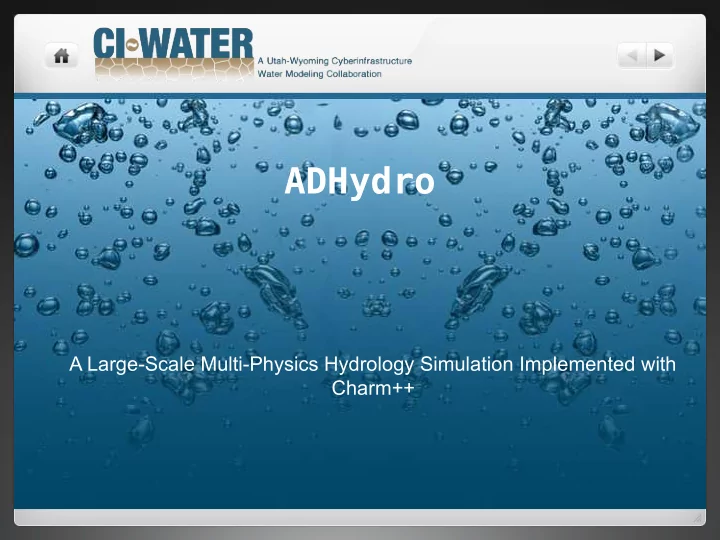

ADHydro A Large-Scale Multi-Physics Hydrology Simulation Implemented with Charm++
Goal:Upper Colorado Watershed on Yellowstone Supercomputer
Goal:Upper Colorado Watershed on Yellowstone Supercomputer Area: 288,000 km^2 Computation nodes: 4536 Streams: 467,000 km Processor cores: 72,576 Population: 900,000 Peak petaflops: 1.504 Population using water: 36 th fastest in world (top500.org) >30,000,000
Research Questions How will climate and land-use changes affect the availability of water for the Upper Colorado watershed states (CO, WY, UT, NM, AZ) over the coming decades? How can water management be optimized, and how much benefit can be realized from such optimization? – E.g. Changing from flood irrigation to center-pivot irrigation
Additional Research Goal Explore high spatial and temporal resolution from a capability-driven perspective.
Capability-Driven Resolution High resolution – Mesh elements as small as 1/2 acre or 100 meters of stream reach Variable resolution – Unstructured mesh – Offline mesh coarsening to explore effects of resolution Adaptive resolution – Implemented for temporal – Not yet implemented for spatial
Multi-Physics We are not a “conceptual” model – Select abstract coefficients to fit historical data We are a “physical” model – All inputs are in theory measurable in the lab
Multi-Physics We model multiple largely independent physical processes API for Independent swappable physics modules – Some are legacy codes “Arbitrary” water management – Irrigation and reservoir releases based on human decisions, not physics
Multi-Physics Explicit first-order simulation Guaranteed to conserve mass Guaranteed to converge
Simulation Architecture Snowmelt Water Rainfall Management groundwater mesh head geometry Groundwater State Variables Infiltration vadose zone surface water state depth Channel Evapo- Network Transpiration Surface Water
Reasons for Using Charm++ Partitioning Load Balancing Checkpointing Easy to overlap computation and communication Doesn't require learning advanced features of C++ – Domain experts are not computer scientists
Recent Implementation Work Regions – Chare objects that contain multiple mesh elements – Reduces chare-switching overhead – Aggregates messages Heterogeneous timestepping – Neighbors agree on flow rate and expiration time and can then independently step forward to expiration time with different timesteps
Heterogeneous timestepping Step 1: Calculate nominal flow rate Each element makes an agreement with each of its neighbors about the “nominal” flow rate between them and an expiration time for this nominal flow rate
Heterogeneous timestepping Step 1: Calculate nominal flow rate This nominal flow rate will not be recomputed until the expiration time – Although less water than that may flow if the sender runs out of water – The expiration time must account for both the Courant number of the flow and factors like looking ahead in the forcing file to detect upcoming shocks
Heterogeneous timestepping Step 1: Calculate nominal flow rate Both neighbors agree to sync up at the expiration time to recalculate a new nominal flow rate and expiration time – Both neighbors must end a timestep end at exactly the expiration time
Heterogeneous timestepping Nominal Flow Rate Expiration Time Nominal Flow Rate Expiration Time Nominal Flow Rate Expiration Time Time Current
Heterogeneous timestepping Step 2: Select timestep Each element selects its timestep end time – This can be no later than its earliest nominal flow rate expiration time, although it can be earlier – It does not have to be the same as any other element's timestep end time except when recalculating a nominal flow rate with a neighbor
Heterogeneous timestepping Nominal Flow Rate Expiration Time Nominal Flow Rate Expiration Time Nominal Flow Rate Expiration Time Time Current End Time Timestep
Heterogeneous timestepping Step 3: Send outflow water Each element calculates its actual outflows for its current timestep including flow limiting if it runs out of water Each element sends messages containing this water to its neighbors
Heterogeneous timestepping Nominal Flow Rate Expiration Time Water Message Sent Nominal Flow Rate Expiration Time Nominal Flow Rate Expiration Time Time Current End Time Timestep
Heterogeneous timestepping Step 4: Wait for inflow water Each element waits until it has received water messages for all of its inflows to at least its current timestep end time – Neighbors might have shorter timesteps so the element may have to wait for multiple water messages from a single neighbor
Heterogeneous timestepping Nominal Flow Rate Expiration Time Water Message Sent Nominal Flow Rate Expiration Time Water Message Received Nominal Flow Rate Expiration Time Water Message Received Time Current End Time Timestep
Heterogeneous timestepping Nominal Flow Rate Expiration Time Water Message Sent Nominal Flow Rate Expiration Time Water Message Received Water Message Received Nominal Flow Rate Expiration Time Water Message Received Time Current End Time Timestep
Heterogeneous timestepping Step 5: Advance time Each element updates its water state and advances current time to the end of its timestep Then the element returns to step 1 if any of its nominal flow rates have expired or step 2 if not
Backup Slides
Heterogeneous timestepping Guaranteed to conserve water A quantity of water is removed from one bucket, and the same quantity of water is added to another bucket Water cannot be received until the sender removes that water from its bucket No element ever sends more water than it has
Heterogeneous timestepping Guaranteed Not To Deadlock If an element is waiting to calculate a nominal flow rate with me its current time must be strictly greater than my current time and its timestep end time must be greater than or equal to my timestep end time If an element is waiting for a water message from me its timestep end time must be strictly greater than my timestep end time
Heterogeneous timestepping Guaranteed Not To Deadlock If an element is waiting on me through a transitive chain that does not include waiting on a water message then its current time is strictly greater than my current time If an element is waiting on me through a transitive chain that does include waiting on a water message then its timestep end time is strictly greater than my timestep end time There can be no cycles in the waits-for graph
Collaborators
Recommend
More recommend